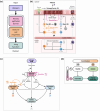Mechanistic modelling of allergen-induced airways disease in early life
- PMID: 39747954
- PMCID: PMC11696187
- DOI: 10.1038/s41598-024-83204-x
Mechanistic modelling of allergen-induced airways disease in early life
Abstract
Asthma affects approximately 300 million individuals worldwide and the onset predominantly arises in childhood. Children are exposed to multiple environmental irritants, such as viruses and allergens, that are common triggers for asthma onset, whilst their immune systems are developing in early life. Understanding the impact of allergen exposures on the developing immune system and resulting alterations in lung function in early life will help prevent the onset and progression of allergic asthma in children. In this study, we developed an in silico model describing the pulmonary immune response to a common allergen, house dust mite, to investigate its downstream impact on the pathophysiology of asthma, including airway eosinophilic inflammation, remodelling, and lung function. We hypothesised that altered epithelial function following allergen exposure determines the onset of airway remodelling and abnormal lung function, which are irreversible with current asthma therapies. We calibrated the in silico model using age appropriate in vivo data from neonatal and adult mice. We validated the in silico model using in vivo data from mice on the effects of current treatment strategies. The in silico model recapitulates experimental observations and provides an interpretable in silico tool to assess airway pathology and the underlying immune responses upon allergen exposure. The in silico model simulations predict the extent of bronchial epithelial barrier damage observed when allergen sensitisation occurs and demonstrate that epithelial barrier damage and impaired immune maturation are critical determinants of reduced lung function and asthma development. The in silico model demonstrates that both epithelial barrier repair and immune maturation are potential targets for therapeutic intervention to achieve successful asthma prevention.
Keywords: Allergen; Asthma; In silico models; Mechanistic modelling; Pre-school wheeze.
© 2024. The Author(s).
Conflict of interest statement
Declarations. Competing interests: The authors declare no competing interests.
Figures






Similar articles
-
Methods for Experimental Allergen Immunotherapy: Subcutaneous and Sublingual Desensitization in Mouse Models of Allergic Asthma.Methods Mol Biol. 2021;2223:295-335. doi: 10.1007/978-1-0716-1001-5_20. Methods Mol Biol. 2021. PMID: 33226602
-
Development of eosinophilic inflammation is independent of B-T cell interaction in a chronic house dust mite-driven asthma model.Clin Exp Allergy. 2017 Apr;47(4):551-564. doi: 10.1111/cea.12834. Epub 2016 Nov 22. Clin Exp Allergy. 2017. PMID: 27743410
-
Subcutaneous and Sublingual Immunotherapy in a Mouse Model of Allergic Asthma.Methods Mol Biol. 2017;1559:137-168. doi: 10.1007/978-1-4939-6786-5_11. Methods Mol Biol. 2017. PMID: 28063043
-
The New Paradigm: The Role of Proteins and Triggers in the Evolution of Allergic Asthma.Int J Mol Sci. 2024 May 25;25(11):5747. doi: 10.3390/ijms25115747. Int J Mol Sci. 2024. PMID: 38891935 Free PMC article. Review.
-
Modeling responses to respiratory house dust mite exposure.Contrib Microbiol. 2007;14:42-67. doi: 10.1159/000107054. Contrib Microbiol. 2007. PMID: 17684332 Review.
Cited by
-
Inhalant Mediated Allergy: Immunobiology, Clinical Manifestations and Diagnosis.Clin Rev Allergy Immunol. 2025 Apr 15;68(1):43. doi: 10.1007/s12016-025-09053-2. Clin Rev Allergy Immunol. 2025. PMID: 40234356 Free PMC article. Review.
References
-
- Barnes, P. J. Immunology of asthma and chronic obstructive pulmonary disease. Nat. Rev. Immunol.8, 183–192 (2008). - PubMed
-
- Belgrave, D. C. M. et al. Lung function trajectories from pre-school age to adulthood and their associations with early life factors: A retrospective analysis of three population-based birth cohort studies. Lancet Respir. Med.6, 526–534 (2018). - PubMed
Publication types
MeSH terms
Substances
Grants and funding
LinkOut - more resources
Full Text Sources
Medical

